-
Channel partner engagement is both essential to – and a reflection of – the strength of your partner relationships.
-
No partner engagement plan can generate long-term results with a partner that isn’t a fit for your company and its services. Make sure you’re targeting best-fit partners upfront.
-
Every partnership is different. Different partners may require different engagement processes.
-
Make sure you’ve got what you need to drive engagement. Partner engagement requires that asset- and partner-enablement processes are in place.
-
In the first 30 days, you and your partner will learn about each other – including the value you can deliver your partners via incentives – and set goals.
-
60 days into your plan, you’ll be educating customers and helping them start to sell your solutions.
-
At the 90-day mark, you’ll be making refinements with partners where needed, starting up your quarterly business reviews (QBRs), and helping your partners go to market with your solutions more extensively.
-
At 12 months and onward, you’re celebrating a successful partnership and keeping the relationship refreshed and renewed through ongoing communication, regular meetings and goal alignment.
It stands to reason that increasing your partner engagement program’s stickiness can help you keep a steady stream of partner revenue flowing. Keeping partners engaged is what long-term channel success is all about, after all. And it’s essential to building those big revenue engines that make the channel such a powerful tool for growth.
In our most recent column detailing partner engagement best practices, we turned to a panel of partner engagement experts and asked them to share some of their best insights for increasing program stickiness. They covered everything from the program challenges to re-engaging inactive partners – all good, actionable advice that can help you get your arms around a complex and challenging subject.
To help put that into a timeline, we asked those same experts to break down a successful engagement program into steps at the following milestones: 30 days, 60 days, 90 days and 12-months-and-onward. Before we dig into those, here are three tips to help you set up your engagement program for success:
TIP #1: Target the Right Channel Partners for Your Company
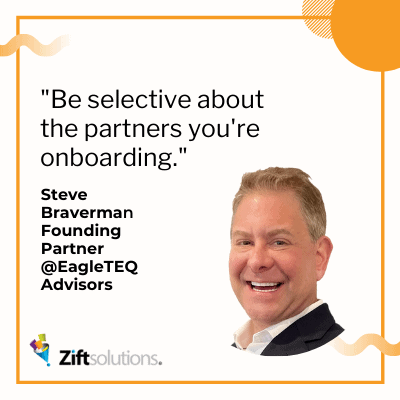 There’s a reason they’re called channel “partners.” Working with them means establishing business partnerships that help both firms succeed. And as we’ve discussed many times in our blogs, webinars and other discussions, finding the right partner for your company is essential to developing a successful partnership. There’s even shorthand for modeling them – they’re called IPPs, or ideal partner profiles.
There’s a reason they’re called channel “partners.” Working with them means establishing business partnerships that help both firms succeed. And as we’ve discussed many times in our blogs, webinars and other discussions, finding the right partner for your company is essential to developing a successful partnership. There’s even shorthand for modeling them – they’re called IPPs, or ideal partner profiles.
Think of them like buyer personas your marketing team develops for retail customers, but instead of helping you target the right accounts for your services, they help you find the right partners to distribute your services.
Steve Braverman, Founding Partner for EagleTEQ Advisors, stresses the importance of this process. “Be selective about the partners you’re onboarding,” he says.
Rackspace Global Partner Manager Vicki Patten agrees. “Don’t try to boil the ocean and be everyone’s partner,” she says. “Focus on great-fit partners and [technology services brokers] that are truly trying to grow with the solutions that you offer. Build strong relationships with those people who can drive their ecosystems to you.”
TIP #2: Tweak the Engagement Process to Meet the Partners’ Needs
For the most part, our experts identified broad trends that you can apply to most business models. But before we dig into those 30/60/90-day benchmarks, it’s essential to recognize that different partners may require different engagement processes.
“Based on their criteria, you can know how to onboard them,” says EagleTEQ’s Braverman, who has experience in technology services broker agency leadership. Once you “understand a partner’s business,” you can “help them understand your business and explain who their touchpoints will be in your company.”
That criteria may not be their business model but the situation at hand. Jeff Mattan, Vice President of Global Partner Programs at BeyondTrust, noted, for example, that the engagement process may be accelerated if there’s a deal on the table. “This all changes if the reason you got engaged in the first place is because the partner has a deal to work on with you,” he says. “In cases like that, it’s a lot faster on-the-job training exercise engaging with the partner and customer.”
TIP #3: Make it Easy for Partners to Engage
You won’t drive partners to engage with you if you don’t make it easy for them. Like you, they’re stretched thin and seeking efficiency at every turn. Channel enablement is essential to onboarding and foundational for driving partner engagement.
30 Days: Getting Started on Your Channel Partner Engagement Plan
We tend to harp on the importance of making a good first impression with partners, but that’s only because it’s true. The first 30 days represent the first big moment of truth for your channel partners in their experience with your company. It’s no surprise that the experts we interviewed had more to say about those first 30 days than any other timeline benchmarks.
Your engagement plan is part of the total partner experience and should sync with your channel partner enablement framework.
Here are some tips from our panel of partner engagement experts:
Get to Know Your Partner
Partners are like everyone else in our overscheduled world – pressed for time but also feeling like nobody has time for them, either. You can get an edge up over your channel competitors by simply scheduling time to learn about your partners and find out what they expect from the partnership and how you can help them alleviate pain points and grow their businesses.
“[In the] first 30 days, I’m just getting to know partners’ businesses and what makes them unique in their own way,” says Tony Burns, Channel Account Manager for Mitel. “Some partners are smaller guys, some are larger, so it’s important to know what their particular goals are.”
Help Partners Get to Know You, Too
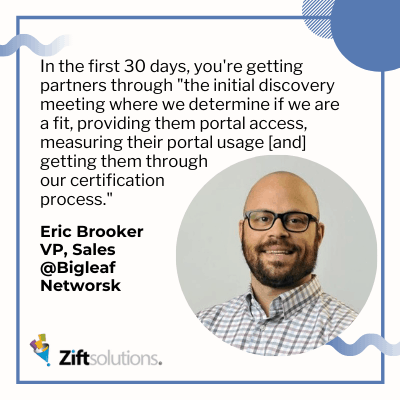 Partners are learning about you, too. It’s essential to make it easy for them to learn about your products – and how to work with your teams – especially when they’re onboarding.
Partners are learning about you, too. It’s essential to make it easy for them to learn about your products – and how to work with your teams – especially when they’re onboarding.
“[Exactly what we address] depends upon the partners,” says BeyondTrust’s Mattan. “Generally speaking, at 30 days, you want partners registering for the portal, taking training and meeting the sales teams. [All the] standard onboarding activities that allow them to learn about you… while you also learn about them by ongoing interaction.”
Eric Brooker, Vice President of Sales for Bigleaf Networks, also emphasizes learning and looking at partner engagement metrics right away. He says his company’s goals for the first 30 days include “getting them through the initial discovery meeting where we determine if we are a fit, providing them portal access, measuring their portal usage [and] getting them through our certification process.”
Jim Tennant, Head of Channels at Replicant, introduces partners to the product offering and target audience and begins discussions about aligning toward common goals.
Set Goals to Keep Partners Engaged from the Beginning
There’s no single rule for a successful partnership – every relationship is unique. But if there’s such a thing as a universal component to success, it’s aligning and setting goals. If you’ve been following our series of blogs with advice from experts across the channel, you’ll have noticed that goal setting is a hot topic. It cropped up in interviews with engagement experts as well.
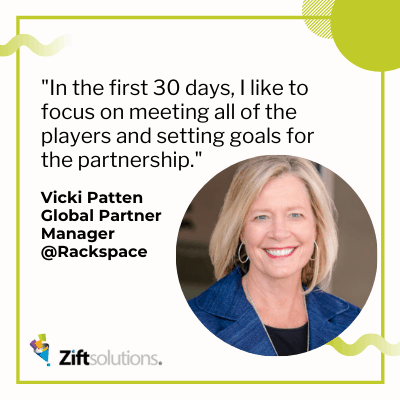 “In the first 30 days, I like to focus on meeting all of the players and setting goals for the partnership,” says Rackspace’s Patten.
“In the first 30 days, I like to focus on meeting all of the players and setting goals for the partnership,” says Rackspace’s Patten.
Jackie Funk, Director of Channel Marketing at Appgate, says her firm includes sales, sales engineering and marketing alignment in the first 30 days.
Offer Incentives to Jumpstart Engagement
“Be sure that your programs incentivize partners,” says Mayka Rosales Peterson, Senior Manager, Managing Partner Program for AppSmart. “And offer the support and tools they’ll need to be successful to sell your solutions and products – there’s value in that.”
“On the technology services broker [agency] side,” she adds, “make sure you’re educating partners (campaigns, webinars, etc.). Be the person who can market [to] the partners’ people. Give them the marketing that they need. Many partners struggle with marketing. Being that person to help them with prospecting, lead gen, brand awareness, what have you, is a full partnership.”
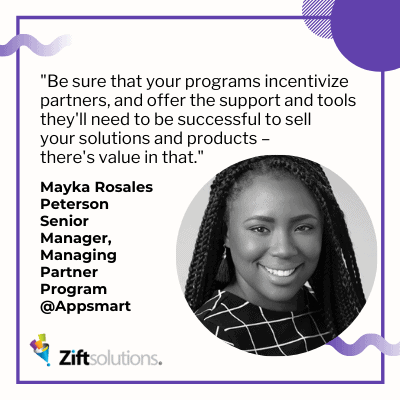 60 Days: Drive Momentum Toward Sales Goals
60 Days: Drive Momentum Toward Sales Goals
In month two, you’re planning activities to reach your shared goals and beginning to execute against those plans. For all practical purposes, the momentum phase starts now. It’s also a good idea to review your partner’s first 30 days and fill any onboarding gaps they identify. Here’s some advice from our expert panel:
Solidify Your Plans
Now is the time to take what you’ve learned from your partners – and what they’ve learned from you – and put plans in place. “In 60 days, I want to have a solid plan for the activities that will drive activities to enable partners at both the technology services broker [agent] and subagents’ companies,” says Rackspace’s Patten.
Just as with goal setting, listening to your partners and getting buy-in on your plans can help you keep your goals front and center. “Schedule an agreed-upon plan that includes cadence of communication and specific activities that are aligned with each other’s initiatives, goals, milestones of success,” advises Jim Tennant from Replicant.
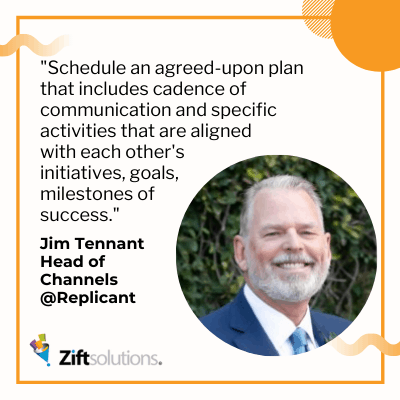 Appgate’s Funk focuses on “understanding the competitive landscape, account mapping and initial field marketing planning/execution.”
Appgate’s Funk focuses on “understanding the competitive landscape, account mapping and initial field marketing planning/execution.”
Help Your Partners Begin Selling
Note that Funk included initial execution with her planning. She’s not alone in that. Many firms emphasize sales collaboration and begin the process of joint selling during this window.
“At 60 days, [channel partner] onboarding continues, and I’d want them to graduate to things like jointly talking to customers as they typically aren’t ready to do it themselves,” says BeyondTrust’s Mattan. “This gives vendor sales teams the opportunity to prove it’s a two-way street by having partners sit in on sales calls and demos.”
In some cases, moving to this step requires education and getting your partners to reframe their perspective and approach. “[At] 60 days, I’m educating,” says Mitel’s Burns. “Partners are so smart, but sometimes, you have to show them a different way or change the way partners view things.”
 90 Days: Get into a Rhythm for Partner Engagement
90 Days: Get into a Rhythm for Partner Engagement
In the third month of working with new partners, your partnership should hit its full stride. Sure, there’s still work to do – that will never stop – but at this point, you can start drumbeat meetings, focus on performance, and help your partners help themselves.
Check Progress Against Goals
“In 90 days, we should see the pipeline building and also have the first Quarterly Business Review to check progress against the goals,” says Rackspace’s Patten.
Funk from Appgate also gets QBRs underway at this point, along with building on earlier planning and execution. At the 90-day milestone, she emphasizes:
- Quarterly planning (goals and tactics to achieve them)
- Demand generation
- Field execution
- Ongoing training and enablement
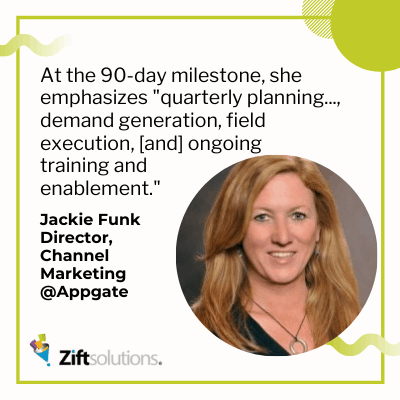 Replicant’s Tennant says his firm focuses on account mapping, event planning and steady cadence on everything established over the first 60 days.
Replicant’s Tennant says his firm focuses on account mapping, event planning and steady cadence on everything established over the first 60 days.
For his part, Mitel’s Burns focuses on being an extension of the partner’s business. “90 days in, I’m really just trying to serve as that extra arm,” he says. “I’m an extra member of their team that they can rely on for little and big things.”
Help Partners Stretch Their Sales Wings
Depending on your business model, you may want your partners to begin taking independent sale steps at this point.
“At 90 days, ideally you want to see them start to approach customers on their own and bring you in as needed instead of relying on you so much,” says BeyondTrust’s Mattan. “I’d also like to see them start to use some of the marketing tools we make available for partner use.”
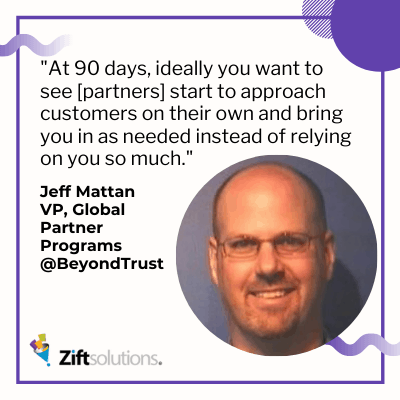 12 Months: What Comes Next?
12 Months: What Comes Next?
Reaching the 12-month mark with an active, engaged partner is a significant milestone. It’s an important anniversary for both companies that’s worth reviewing and celebrating.
Jackie Funk at Appgate says their organization conducts an annual evaluation, which includes reviewing alignment, evaluating wins (to replicate success in all territories) and checking that the sales/marketing engine is running smoothly. This ensures that Appgate is investing in the partners who are helping to drive revenue and pipeline.
At this point, the partner relationship should be running as planned. In other words, they’re likely to give you the benefit of the doubt if there are hiccups. However, they’re still a hot target for your competitors, so don’t rest on your laurels or take the relationship for granted.
Conduct and Continue QBRs
Leading up to this point, you will have developed your partnership, closed business, reviewed metrics and refined your objectives.
“Over 12 months, we should see our first sales closing together and continue the QBRs, and reset goals as is appropriate,” says Rackspace’s Patten.
Replicant’s Tennant also sees driving engagement in long-term partnerships as a matter of consistent communication and realignment. “Conduct QBRs to review and fine-tune [everything you’ve done to date], review pipeline opportunities and [what you’ve learned across the partnership],” he says.
Leverage Data and Deeper Connections to Drive More Sales
Data analytics on such things as portal activity, use of marketing campaigns and other marketing materials, and leaderboards can help to fuel your relationship long term. Both parties have a role to play in that equation.
Mattan of BeyondTrust likes to see partners engaged deeply with his organization at this point. “At 12 months, I’d love the partner to be a regular visitor to the partner portal, running our marketing campaigns, engaging more with our sales teams than our CAMs (channel account managers) and leveraging our sales tools to help their customers and making money from both sales and services,” he says.
Mattan also remains engaged, helping partners benchmark their performance levels and sharing the activities that have proved to move the needle. “On my side, I’d be sharing leaderboards on their various activity levels that drive combined pipeline,” he says.
Laz Gonzalez
Laz Gonzalez is Chief Strategy Officer at Zift Solutions. A prominent industry analyst and thought leader, Gonzalez brings unparalleled channel expertise to Zift and has served as strategic adviser to leading B2B channel programs worldwide.




